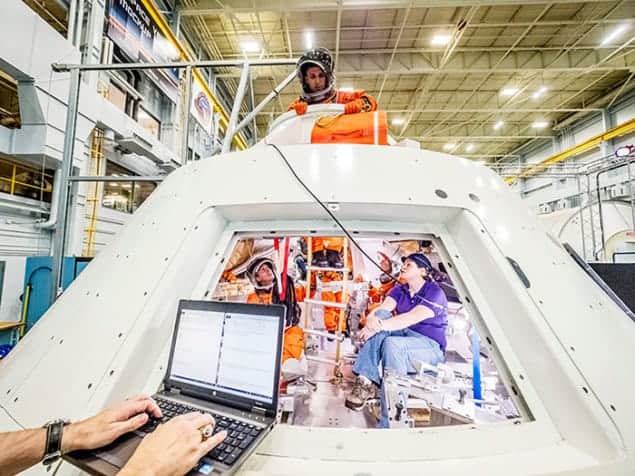
Concerns have been raised by US watchdogs over NASA‘s ambitious plans to send astronauts to Mars in the 2030s. In two reports (see related links) published last week, the US Government Accountability Office (GAO) – which audits government agencies on behalf of the US Congress – warns that tackling “several technical challenges” with the Orion capsule for transporting astronauts to Mars would push costs above the current estimated price tag of $11.3bn.
NASA’s schedule to Mars involves a series of tests of the Orion crew capsule and the Space Launch System (SLS), which is designed to launch Orion towards the red planet. The agency plans its first launch of the SLS late next year – preferably in September and no later than November. Called Exploration Mission 1 (EM-1), the test flight will carry a crewless Orion capsule around the Moon.
The second flight, dubbed EM-2, meanwhile, will carry a four-person crew in the Orion capsule by April 2023. But NASA wants to fast track the launch for August 2021, in what it calls an “aggressive” push. The mission will lift astronauts beyond low-Earth orbit for the first time since the Apollo 17 Moon landing in 1972, where they will practise manoeuvres with the craft.
Later in the decade, NASA then plans to use a robotic mission to capture an asteroid and redirect it into lunar orbit. Astronauts on a fresh Orion mission will explore the asteroid and return to Earth with samples from it. That flight will serve to test new systems – such as solar electric propulsion – for the eventual Mars mission.
Risk and reward
The two GAO reports cast doubt on NASA’s schedule, adding that the cost estimate “lacked support”. They assert that NASA has to tackle a number of issues with the launch site at the Kennedy Space Center in Florida to accommodate the SLS, which could delay the launch beyond 2018. “All the programmes are working with very low management reserves in terms of dollars and time,” says Cristina Chaplain, GAO’s director of acquisition and sourcing management, who led the studies. “It makes it very difficult to manage a programme under those circumstances. It puts them in a position of deferring work to later stages, where it could be more costly and time-consuming to address.”
The GAO adds that NASA only has a 40% chance of meeting the August 2021 date for EM-2, and that by setting such a goal the agency is accepting higher risk. In a response included in the report, Bill Gerstenmaier, NASA associate administrator for human exploration and operations, concedes some of the criticisms, but regards others as unnecessary. “To date, as the GAO correctly noted, Orion continues to perform within the boundaries of the programme cost and schedule commitment,” he writes.
While the situation may seem serious, some regard it as not unusual, given the nature of crewed space missions. “I would have some concerns, but I’m not terribly worried,” says Scott Pace, director of George Washington University’s Space Policy Institute. “For Orion, cost and risk are being traded in a responsible manner.” Yet he questions the early target date for EM-1. “The political support for pulling the schedule in closer is not there now,” he says.
Meanwhile, the US government has approved the first commercial mission to the Moon. The Federal Aviation Administration’s Office of Commercial Space Transportation gave the go-ahead for the Moon Express company to send a robotic lander to the lunar surface next year. Based in Cape Canaveral, Florida, Moon Express plans to equip its small table-sized lander with experiments and commercial cargo, including some cremated human remains.



